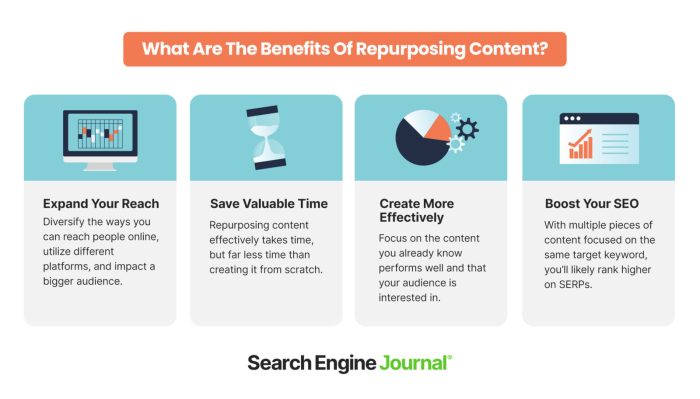Developing a Content Repurposing Plan kicks off the party with a bang, showing you how to revamp your content game and reach a wider audience. Get ready to dive into the world of repurposing like a pro!
Let’s explore the steps involved in creating a killer repurposing strategy and how to adapt your content to different platforms for maximum impact.
Importance of Content Repurposing

Content repurposing plays a crucial role in digital marketing strategies by maximizing the value of existing content. It involves transforming content into different formats to reach a wider audience and enhance engagement.
Benefits of Content Repurposing
- Improved : Repurposing content allows you to target different s and increase your online visibility. By creating various versions of the same content, you have more opportunities to rank on search engine results pages.
- Enhanced Audience Engagement: Repurposing content helps you connect with your audience on multiple platforms and in different ways. Some people prefer reading articles, while others enjoy watching videos or listening to podcasts. By repurposing content, you can cater to diverse preferences and keep your audience engaged.
Successful Examples of Content Repurposing
HubSpot
is a prime example of a brand that excels in content repurposing. They repurpose their blog posts into various formats such as infographics, videos, and social media posts, reaching a larger audience and driving more traffic to their website.
Buffer
is another successful brand that effectively repurposes content. They turn their blog posts into podcasts, email newsletters, and social media updates, providing valuable content to their audience in different formats.
Developing a Content Repurposing Strategy

Creating a content repurposing plan involves several key steps to ensure effectiveness and efficiency in reaching the target audience.
Identifying Content Pieces for Repurposing
To identify content pieces suitable for repurposing, consider the following tips:
- Review your existing content library to find evergreen topics that can be updated or repackaged.
- Look for high-performing content that can be transformed into different formats such as videos, infographics, or podcasts.
- Consider trending topics or themes that can be revisited and expanded upon to provide fresh insights.
Aligning Repurposed Content with the Target Audience’s Preferences
It is essential to align repurposed content with the preferences of your target audience to maximize engagement and impact. Some tips to achieve this include:
- Conduct audience research to understand their interests, pain points, and preferred content formats.
- Tailor the repurposed content to resonate with the audience’s language, tone, and style to enhance relatability.
- Utilize feedback and analytics to refine and optimize the repurposed content based on audience responses and interactions.
Types of Content Repurposing: Developing A Content Repurposing Plan
When it comes to content repurposing, there are various ways to breathe new life into your existing material. From transforming a blog post into a captivating video to creating an engaging infographic, the possibilities are endless.
Repurposing for Different Platforms, Developing a Content Repurposing Plan
Adapting your content for different platforms is crucial in reaching a wider audience. Whether it’s optimizing your content for social media, crafting compelling email newsletters, or repurposing for podcasts, each platform requires a unique approach to maximize engagement.
- Turning a blog post into bite-sized social media posts with eye-catching visuals can help boost your online presence and drive traffic to your website.
- Repurposing content for email newsletters by summarizing key points or providing exclusive insights can help nurture leads and build customer relationships.
- Creating podcast episodes based on your existing content can offer a new way for your audience to consume information and connect with your brand on a deeper level.
Examples of Creative Content Repurposing Strategies
Businesses are constantly innovating and finding creative ways to repurpose their content to stay relevant and engage their audience. Here are some examples of successful content repurposing strategies:
- Repurposing a series of blog posts into an e-book that serves as a comprehensive guide for readers.
- Transforming customer testimonials into visually appealing graphics to share on social media and build credibility.
- Creating behind-the-scenes videos showcasing the making of a popular blog post to give your audience a glimpse into your creative process.
Tools and Resources for Content Repurposing
When it comes to repurposing content efficiently, having the right tools can make a significant difference in streamlining the process. Automation tools, in particular, can help save time and effort by automating repetitive tasks and allowing you to focus on creating high-quality content. Here are some popular tools that can assist you in your content repurposing efforts:
Automation Tools for Streamlining Content Repurposing
- 1. Buffer: This tool allows you to schedule posts across multiple platforms and analyze their performance, making it easier to repurpose content for different audiences.
- 2. Canva: Canva offers a wide range of templates and design tools to help you create visually appealing graphics for your repurposed content.
- 3. Hootsuite: With Hootsuite, you can manage all your social media accounts in one place, making it easier to repurpose and share content seamlessly.
Maintaining Quality While Repurposing Content
While automation tools can streamline the content repurposing process, it’s essential to ensure that the quality of your content is not compromised. Here are some insights on how to repurpose content effectively without sacrificing its quality:
- 1. Customize for Different Platforms: Tailor your content to fit the specific requirements and preferences of each platform, whether it’s social media, blogs, or email newsletters.
- 2. Update and Refresh: Keep your content relevant by updating statistics, adding new insights, or incorporating current trends to maintain its value and appeal.
- 3. Repackage in Different Formats: Transform your content into different formats like videos, infographics, or podcasts to reach a wider audience and keep it engaging.